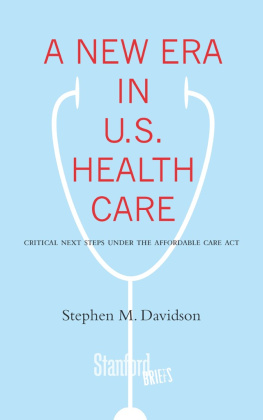Stanford University Press
Stanford, California
2013 by the Board of Trustees of the Leland Stanford Junior University.
All rights reserved.
No part of this brief may be reproduced or transmitted in any form or by any means, electronic or mechanical, including photocopying and recording, or in any information storage or retrieval system without the prior written permission of Stanford University Press.
Printed in the United States of America on acid-free, archival-quality paper
Library of Congress Cataloging-in-Publication Data
Davidson, Stephen M., author.
A new era in U.S. health care : critical next steps under the Affordable Care Act / Stephen M. Davidson.
pages cm
Includes bibliographical references.
ISBN 978-0-8047-8700-0 (pbk. : alk. paper)
1. Health care reformUnited States. 2. United States. Patient Protection and Affordable Care Act. 3. Medical policyUnited States. 4. Health insuranceUnited States. I. Title.
RA395.A3D384 2013
362.10973dc23 2013005362
ISBN 978-0-8047-8723-9 (electronic)
Typeset by Classic Typography in 10/13 Adobe Garamond
P ROLOGUE
In the spring of 2010, I published a book about the U.S. health care system. It described how the system works and the problems that result from its operation. I made the case that those problems needed to be solved because they threatened the systems future and were undermining the ability of Americans to get good care when they needed iteven when they had health insurance.
Moreover, I argued, the solution required that the federal government take a large role because the national system as a whole needed to changeand more quickly than if we relied on the normal evolutionary process built by the accumulation of individual actions. The main reason for both reform and a large federal role in it was that existing system dynamics were leading inevitably to further system deterioration even though each individual and each group were making decisions they thought were best for them.
The book also demonstrated that the origin of the problems lay primarily in dysfunctional incentives faced by all parties to the systememployers, insurers, individuals and families, providers of services, and even federal and state governments. All were making choices they thought were rational for themselves, at least in the short run, but when added together, those choices created problems for the system and the nation. Any real solutions, therefore, needed to include changes to those incentives, especially as they affected utilization decisions made by patients and their doctors.
Finally, I discussed the politics of reform, drawing key lessons from the history of the many prior attempts at system improvement. The central conclusion: no matter how compelling a case could be made on the merits, real reform faced an uphill legislative battle, making passage of a new law designed to produce comprehensive system change a long shot at best.
Yet in March 2010, against all odds, President Barack Obama was able to get the Congress to pass the Patient Protection and Affordable Care Act (ACA). Two weeks before the book appeared, he signed it into law.
The main purpose of this new book is to consider the future of the health care systemstill struggling with the problems described in the previous book, but now with the advantage of the tools provided by the ACA. In I will examine several important issues that will help to determine the ACAs ultimate accomplishments: the role of Medicaid and the states; the implementation process; the creation of health insurance exchanges in the states; and the use of a new organizational form, accountable care organizations. I have selected these issues because they will have such a large role in determining the extent to which the ACA achieves its aspirations. If they and other provisions work as intended, doctors, patients, insurers, and others can over time actually change the health care system for the benefit of all Americans. It wont be quick, but we will be moving in the right direction.
Any book project that hopes to finish in a reasonable time requires help, and I have been fortunate to have had the assistance of two talented Boston University undergraduates. Both were admitted to the seven-year B.A./M.D. program and are now students at the Boston University Medical School. They are Ankit Agarwal and Ashwini Kerkar. They were enthusiastic, energetic, and creative in helping me locate useful references and were generous in offering their comments and questions as well, unintimidated by the differences in our age and experience. I am the beneficiary of their intelligence, insights, and hard work.
I have also been fortunate to work again with Margo Fleming, senior editor at Stanford University Press. She suggested the concept for this book and envisioned it as an early entry in the Presss new Stanford Briefs series of relatively short books for professionals and educated laypeople on important topics in a variety of fields. I was delighted to take her up on the idea, which I viewed as an opportunity to examine the health system challenges laid out in the earlier book, Still Broken, in the context of the Affordable Care Act. Margo was a pleasure to work with, not least because of her patience and support during my recuperation from the total hip replacement I needed after having broken my original one in a fall while playing tennis. I got to see firsthand the health system when it operates as all of us hope it will, with competence and efficiency, and produces a perfect result. Unfortunately, however, it set our schedule back by two-and-a-half months, during which Margo expressed encouragement but never impatience.
Finally, I am blessed to be able to acknowledge again the great debt I owe Harriet, my wife and partner for many years. We have not only collaborated professionally but together raised a wonderful familynow well into a new generationtravelled the world, and shared a life with more high points than can be enumerated. I am forever grateful for all she has done for and with me over our many years together.
HEALTH SYSTEM PROBLEMS SUMMARIZED
Most everyone agrees that the many problems affecting health care in the United States can be grouped under three broad categories: access, cost, and quality. Some disagree, however, with the idea that the problems require a solution in which the public sector plays a large role or, alternatively, about what that role should be. To be able to assess for ourselves these and other difficult issues, we first need to come to an understanding about the problems in some detail.
Health system problems can be defined either by focusing on stories of individuals who, much as they would like to, are not able to use the health services they need or by reciting aggregate statistics that describe system problems at the national level. Some people are much more energized by one approach; some by the other. In the next few pages, I will summarize the problems using both approaches.
THE INDIVIDUAL PERSPECTIVE
There are three main reasons why Americans may lack access to needed services. One is that they live in areas with an inadequate supply of doctors, hospitals, and other professionals and facilities. These tend to be people living in rural areas where the population is too sparse to allow health care professionals and facilities to sustain themselves financially. Although this is an important part of the overall problem, we will not concentrate on it here.









